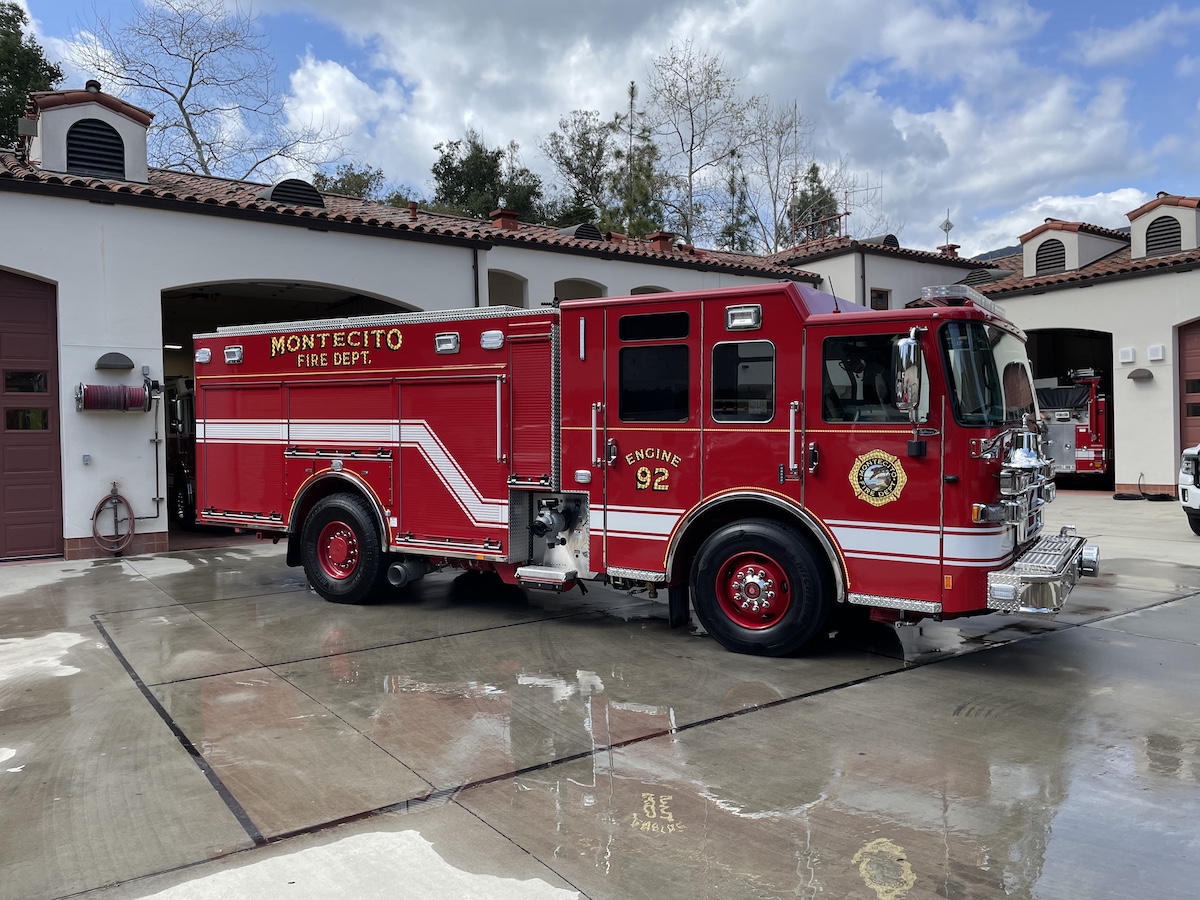MFPD Board At-Large: Q&A with the Candidates

As the concern for wildfire is a major topic in the area and considering the role that the Montecito Fire Protection District (MFPD) plays in our community, the Montecito Journal wanted to reach out to each of the five candidates running for the three open seats in the November 5th general election.
The MFPD is a progressive organization committed to the protection of people, property, and the environment. As part of the community, they exist to provide professional and timely service through preparation for, response to, and recovery from emergencies. The Board of Directors is responsible for governing the MFPD. The Board currently consists of five members, each of which serves a four-year term. (Source: montecitofire.com)
Jason Copus
Q. What is your vision for the future of fire protection and emergency services in Montecito, and how do you plan to address the specific challenges our community faces?
A. My vision is to ensure that Montecito remains one of the most fire-resilient and disaster-prepared communities in California. To achieve this, I would prioritize wildfire prevention measures, expanding community education on fire preparedness, and ensuring our fire district continues to adopt the latest technologies for fire responses and medical emergencies. Additionally, I believe we must continue to work closely with other local and state agencies to create a unified response for regional disasters, including floods and earthquakes. With the increase in frequency of wildfires and other natural hazards, our board must remain proactive and innovative in safeguarding our community.
Q. Can you share an example of a time when you had to lead a team through a high-pressure or crisis situation? What did you learn from that experience?
A. One significant experience that stands out is the morning of the 2018 Montecito Debris Flow. Around 4 am, just before the debris reached Coast Village Road, I was called to the Montecito Inn after an alarm went off in our ground-floor suites. Guests were being evacuated to the main lobby, and I arrived to assist. By the time I reached the property, the debris flow had already inundated the hotel, flooding the area. It was a terrifying moment, and I suddenly found myself responsible for the safety and well-being of over 100 people trapped inside.
For the next several hours, I focused on ensuring that our guests were safe, had access to food and water, and that those who had evacuated quickly were provided with blankets to stay warm. At daybreak, the scale of the disaster became clear. The debris flow had settled, and I could see survivors coming from Olive Mill, North Jameson, and the 101, seeking safety and shelter.
With seven years of emergency response, search and rescue, and first aid/CPR experience from my time with the Coast Guard, I was able to assist those in need and guide them to safety. As more good Samaritans arrived, many were unsure of how best to help. Drawing on my crisis training, I quickly developed an effective plan, delegating tasks in a way that allowed others to contribute meaningfully to the rescue effort.
This experience taught me the importance of remaining calm and organized in the face of chaos. It reinforced the value of preparation, adaptability, and strong leadership during a crisis. Most importantly, it highlighted how crucial teamwork and clear communication are when lives are at stake, and it deepened my understanding of how to effectively lead others in high-pressure situations.
Q. How would you balance fiscal responsibility with ensuring the Fire Protection District remains well-equipped and prepared for future emergencies?
A. Fiscal responsibility is crucial, but public safety must always be the top priority. I would work to strike a balance by closely reviewing the district’s budget to ensure we are maximizing the efficiency of every dollar spent. This might involve finding cost-effective equipment upgrades, identifying grants and state funding opportunities, or forming partnerships with other agencies to share resources. However, I would also advocate for an ongoing assessment of our district’s needs – cutting costs should never come at the expense of readiness. I believe we can be both financially prudent and fully prepared by continually evaluating and optimizing our investments in training, personnel, and technology.
Sylvia Easton
Q. What is your vision for the future of fire protection and emergency services in Montecito, and how do you plan to address the specific challenges our community faces?
A. The Board of Directors sets policy for the Fire District. We work closely with the Fire Chief. The Board enlisted studies which include a Strategic Plan, Evacuation Study, Fire Station Location Study that includes a Standard of Cover and Community Risk Assessment, a robust Vegetation Management Program along with communication upgrades, and support of a Regional Fire Communications Center. Based on recommendations from the studies and staff reports, the Board implements policies to prepare the Fire District for current and future life safety events.
I believe that the Fire District must meet the challenges that are unique to our community. I serve on the Strategic Planning Committee, which assesses those risk factors. The strategic goals and objectives, both short and long term, are designed to protect “people, property and the environment” in a professional and efficient manner through “preparation, response and recovery from emergencies.”
Q. Can you share an example of a time when you had to lead a team through a high-pressure or crisis situation? What did you learn from that experience?
A. I served on the Board of Directors during the Thomas Fire and subsequent debris flow, including the aftermath of those disasters. I had the opportunity to see our highly trained fire professionals serve the community with the upmost expertise and compassion.
Additionally, they worked with our mutual aid partners from near and far, organizing and coordinating the entire operation in the most effective way. They truly saved lives in the process. I also served during the COVID-19 pandemic. l learned how important it is, as a board member, to support upgrading vehicles, equipment, communication systems, medical supplies and more to serve our community in emergencies.
Q. How would you balance fiscal responsibility with ensuring the Fire Protection District remains well-equipped and prepared for future emergencies?
A. The Board of Directors works with the Fire Chief to ensure standards set by industry best practices are observed. The Board approves the annual budget with both short- and long-term goals. This includes vehicle and equipment upgrades, fire station maintenance, funding reserve accounts, meeting payroll and retirement obligations. We review all financial income and out flow every month. The Board of Directors approved a Pension Obligation Bond in 2021 that will substantially reduce the Pension liability. The bond will be fully paid off in 2029.
Cliff Ghersen
Q. What is your vision for the future of fire protection and emergency services in Montecito, and how do you plan to address the specific challenges our community faces?
A. My response here is that I see the responsibility of the MFPD Board to further extend fire prevention awareness and preparation to all the residents of Montecito, and to provide the fire department with up-to-date, reliable equipment that they feel best meets their needs. Communication is, of course, the key. With the Fire District’s new website, reports to the community, and constant interaction with residents, we are moving forward with that goal. Folks in Montecito live in an area surrounded by chaparral, trees, and brush, and residents must be alert to do as much as they can to make their properties more fire resistant – for example, clearing brush near their structures, each spring.
Regarding rain and runoff, I believe we need to monitor and periodically clean out our creek beds to make them ready for winter rains, and also to ensure good drainage systems at our homes and in our neighborhoods. I was in favor of the ring nets when they were up. I have heard that there are drainage issues in and around the Hedgerow area and I would like to work with the neighbors there, the County Roads Dept and County Flood Control to improve the situation in that part of town.
There is also at the present time controversy regarding the providers of ambulance services to the south county, which I hope to learn more about. I will work with the other directors and the fire department officers to discover more about this situation.
Lastly, in our community, we need good evacuation plans from different parts of the area. I’m concerned about the growing traffic-related problems that may be caused by additions to the Miramar and the Biltmore, as well as expansion proposals by the Music Academy, the Coral Casino, and the Y. These expansions may have an impact on safe routes for evacuations, so with the help and leadership of Chief Neels and my colleagues, I am confident that we can make continued progress in keeping Montecito prepared and safe.
Q. Can you share an example of a time when you had to lead a team through a high-pressure or crisis situation? What did you learn from that experience?
A. Other than earthquake drills, fire drills, and lockdowns at my school when I was teaching, I would say the best example in this regard was in 2016 while I was on the board of the Montecito Association. I was the cochair of the Montecito Fourth of July celebration. Although it was not a crisis, there were certainly myriad things to arrange, people to contact, equipment to secure, funds to raise, and logistics to organize! In order to pull off the grand parade with jeeps and antique cars and hold a successful community picnic with games and booths where 1000+ people attended, there were many things that needed to be done! From printing T-shirts to ordering hotdogs, tasks needed to be accomplished within a tight time frame!
Without the help of a knowledgeable, enthusiastic, and energetic group of coworkers from the community, this would’ve been an impossible task! But all those people working together made it fun and doable. I learned that there are many dedicated and skillful people who volunteer their time and intelligence – and muscle – here in Montecito, and I also learned that we have to work together to accomplish great things, especially a good old Montecito Fourth of July celebration!
Q. How would you balance fiscal responsibility with ensuring the Fire Protection District remains well-equipped and prepared for future emergencies?
A. This I must humbly say will certainly be part of my learning curve when I am elected to the board! The MFPD is blessed with a reliable source of income, and the chief financial controller, who reports to the board, has been doing a top-notch job at her duties for several years now. She is somewhat of an unsung hero, extremely accurate, trustworthy, frank with the board, and realistic.
The team of firefighters under the leadership of Chief Neels maintains their physical fitness and their equipment to a high-level, and frequent drills, ongoing training, and equipment testing ensure that it is operational and effective.
I have also seen where the chief and battalion commanders are often attending workshops with their peers, where they learn about and share information on the latest firefighting strategies and emergency equipment. We are blessed to be in such good hands here in Montecito.
Michael N. Lee
Q. What is your vision for the future of fire protection and emergency services in Montecito, and how do you plan to address the specific challenges our community faces?
MFPD’s vision for the future includes risk assessment of clearing and treatment of front-country mitigation, an improved response to eastern district and the possibility of a partnership with Summerland Carpinteria District as well as the ongoing coordination of fire and ambulance programs.
Q. Can you share an example of a time when you had to lead a team through a high-pressure or crisis situation? What did you learn from that experience?
A. Though, not a crisis situation, my involvement with the Board’s support of our latest Fire Chief, David Neels was extremely important to insure a smooth transition of leadership and continued excellence.
Q. How would you balance fiscal responsibility with ensuring the Fire Protection District remains well-equipped and prepared for future emergencies?
A. My time and attention to detail of the Board’s Finance Committee gives me a unique perspective on personnel, retirement, equipment and training with a special attention to future needs of MFPD’s responsible balanced budget.
I appreciate your vote!
Joseph Michael Pennino
Q. What is your vision for the future of fire protection and emergency services in Montecito, and how do you plan to address the specific challenges our community faces?
A. As someone who spent 31 years as a firefighter and Fire Marshall in Santa Monica, CA, I spent my entire professional career working to improve the preparedness, responsiveness, and overall fire life safety for my community. Montecito faces a unique set of challenges, and we need experienced leadership willing to go the extra mile to challenge the norms and do what’s necessary to keep us all safe. Here are a few key items that I would propose we prioritize and address:
– Montecito is an amazing place and its beauty continues to attract more visitors each year, which is leading to an increase in the use of our natural habitats and natural scenic trails. On any given weekend or holiday, we are now experiencing hundreds of day hikers and some illegal overnight campers. This inevitably puts strain on our limited resources. A sound fire prevention strategy should include increasing amounts of preventative and educational measures. Policies that push to increase signage at trailheads as well as on the trails would be effective. Additionally, deploying a patrol presence of uniformed personnel at and around our trailheads and parking areas during these peak usage times would assist in educating and reminding the public of the increased fire life safety hazards. This burden should be shared throughout our community and assets.
– Another critical and important challenge facing our community is our emergency and ambulance services. I realize this issue is currently in the courts. However, I do believe our current response time (on-scene) for ambulance service is ranging around the 9-minute mark. I believe we need to do better. I personally know how crucially important the initial on-scene patient stabilization and trauma center arrival time is to the outcome in most medical cases. We need to have a community housed ambulance station-type location within our community. This is essential in augmenting the move-up type of transportation model we currently share today. Additionally, the community staging of these ambulance units simply means increased ambulance availability for our community needs. Also, if we elect to add a “Montecito” exclusive ambulance designation, the logistics of placing and housing this unit would be a non-issue. The complexities with my vision are many, but prior to my retirement in 2008 there were community exclusive designated first responding units through the nation.
– Lastly, we are facing the potential expansion of our community with the addition of the Miramar project and the re-opening of the Biltmore. This will also affect our current fire life safety resources in several key areas. First, the location of these projects. Increased traffic will impact response times and response patterns, as well as the added use of our first responding assets. I believe a reassessment of how resources are allocated in the most efficient ways in deploying them should be a top priority.
Q. Can you share an example of a time when you had to lead a team through a high-pressure or crisis situation? What did you learn from that experience?
A. On July 16, 2003, while working as the Senior Fire Prevention Inspector for the City of Santa Monica I responded to a mass-casualty incident at the 3rd Street Promenade’s Farmers Market.
As part of the first response support team on the scene, I quickly assessed what was a devastating two to three blocks of mowed down displays, vegetable and fruit tables, tents, many injured and confused people, several mutilated bodies. I reported to the IC and quickly worked to establish a stationary Command Center, which I did using an on-site city project trailer. As resources arrived, I worked to coordinate across local, county, and state levels. This was a highly chaotic incident that through quick organization and teamwork led to the immediate treatment of the injured and mitigating factors, such as (gasoline leaks, natural/LPG gas leaks, water run-off and human bio-waste).
While at the Command Center I realized the importance of the Incident Command Organization. There must be experienced leadership and staff and personnel must be well trained and able to function at all levels under pressure. That day, I acted in a wide variety of capacities from communications, logistics, staging and deploying of incoming resources and anything else that was required to stabilize the situation. My final assignment was to decontaminate the scene. Reflecting back, I can say unequivocally that a solid Incident Command model is vitally important for successful organizations emergency services incidents. And in my experience, it all starts and ends with leadership.
Q. How would you balance fiscal responsibility with ensuring the Fire Protection District remains well-equipped and prepared for future emergencies?
A. Fiscal responsibility is always challenging. During my 31-year career with the City of Santa Monica Fire Department I operated a family-owned property management business and ran and operated a small, residential construction business, JMP Construction. After years of managing budgets and resources I’ve learned to be fiscally sound and learned to operate nimbly and creatively getting the absolute most out of every budget. I plan to bring this mentality to Montecito and believe that through planning and prevention, appropriate resource allocation, and forward-looking strategic leadership we can mitigate risks and respond to the dynamic challenges our community faces today.
We live in a special community. In my opinion, our community deserves the very best, fire and life safety, general services, everything. I had the opportunity and attended a Fire Board meeting and left with this impression. The current board is a high functioning board of directors with good personnel and good leadership. I’m new to the community (four to five years), made some wonderful friends and absolutely believe I’ve extended my life because I love this place. So, I was approached to run for the board and felt it was a good way of me giving something back.
Whatever the results of this election. I wish the best for all candidates.







